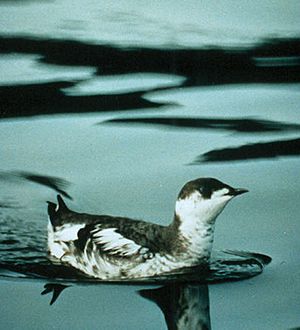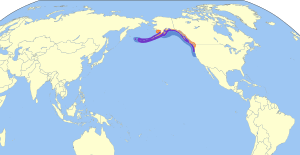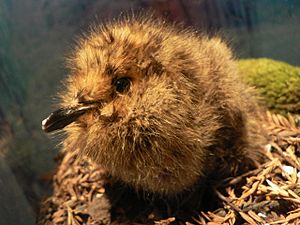Marbled murrelet facts for kids
Quick facts for kids Marbled murrelet |
|
|---|---|
 |
|
| Conservation status | |
| Scientific classification | |
| Genus: |
Brachyramphus
|
| Species: |
marmoratus
|
 |
|
The marbled murrelet (Brachyramphus marmoratus) is a small seabird that lives in the North Pacific. It belongs to the auk family, which are diving birds. This bird is special because it nests in very old, tall forests. Sometimes, in colder northern areas, it nests on the ground where trees don't grow.
For a long time, people didn't know where these birds nested. It wasn't until 1974 that someone found a chick in a tree. This made it one of the last North American birds whose nest was discovered! Sadly, the number of marbled murrelets has dropped. This happened because people started cutting down the old trees where they nest. Because of this, the marbled murrelet has become a symbol for protecting old-growth forests.
Contents
What is a Marbled Murrelet?
The marbled murrelet is a small bird, about 25 centimeters (10 inches) long. It's a chunky bird with a thin black beak. Its wings are pointed, and its feathers change color depending on the season.
In winter, its belly is white, and its head, back, and wings are black. It looks a lot like its close relative, the Long-billed murrelet. For many years, scientists thought they were the same species.
When it's time to breed, both birds have brown, mottled bodies and faces. The Long-billed murrelet has a pale white throat, which the Marbled murrelet doesn't have. In winter, the Marbled murrelet has a white collar around its neck, which the Long-billed murrelet lacks. The Marbled murrelet also has a shorter beak and is a bit smaller.
Marbled Murrelet Behavior
Diet and Feeding Habits
Marbled murrelets find their food in the ocean. They feed in open ocean areas, especially where deep water currents bring nutrients to the surface. They also feed closer to shore in protected bays and inlets. These birds always stay near the Pacific coast of North America. Any similar birds seen far inland are usually the related long-billed murrelet.
These birds dive underwater to catch small fish and tiny sea creatures. Some of their favorite foods include sand lance, Pacific herring, and capelin. They also eat small shrimp-like creatures called Euphausia pacifica and Thysanoessa spinifera.
Marbled murrelets often feed in pairs. They don't usually gather in huge groups like other auk birds. Sometimes, in winter, you might see loose groups of 500 or more birds. Young birds often feed alone. Marbled murrelets feed both during the day and at night.
Reproduction and Life Cycle
The marbled murrelet's nesting behavior is very special. Unlike most other auk birds, they don't nest on cliffs or in burrows. Instead, they build their nests on large branches of very old conifer trees. These trees can be as far as 80 kilometers (50 miles) inland. They use trees like Western hemlock, Sitka spruce, Douglas fir, and coastal redwood.
They lay just one egg on a platform made of lichen or moss on these branches. Sometimes, in northern areas, they nest on the ground among rocks. The egg is kept warm for about a month. Then, the chick is fed for around 40 days until it is ready to fledge (fly for the first time).
Adult birds fly from their ocean feeding areas to their inland nests. They mostly do this at dusk and dawn. They feed their chicks at least once, and sometimes twice, each day or night. Usually, they bring only one fish to the young bird. After it leaves the nest, the chick flies to the sea all by itself. Sadly, not many chicks survive, and many young birds die.
Marbled murrelets don't start breeding until they are at least two years old. They nest from mid-April to late September. The busiest nesting time is from mid-June to late July in California. In Oregon, it's from the second week of July to mid-August. They sometimes nest somewhat close to each other. For example, two nests in Washington were found only 46 meters (150 feet) apart. Not all adult birds nest every year.
Young marbled murrelets stay in the nest longer than other auk chicks. They grow their first flight feathers before they leave the nest. Once they fledge, they fly directly from the nest to the ocean.
Where Marbled Murrelets Live
Habitat and Distribution
In summer, marbled murrelets live from Alaska's Kenai Peninsula and Aleutian Islands south along the coast of North America. Their range extends to Point Sal in south-central California. In winter, they mostly stay in the same areas. However, they tend to leave the very northern parts of their range, especially where ice forms on the water. They have been seen as far south as Imperial Beach in San Diego County, California.
Marbled murrelets are coastal birds. They mostly live near saltwater, usually within 2 kilometers (1.2 miles) of the shore. However, they have been found far inland. For example, they've been seen up to 95 kilometers (59 miles) inland in Washington. In Oregon, they are most often seen within 20 kilometers (12 miles) of the ocean. Many marbled murrelets also visit coastal lakes. Most of these lakes are close to the ocean, but some birds have been found at lakes as far as 75 kilometers (47 miles) inland. All lakes they use are in areas where they might nest.
Nesting Habitat
From southeast Alaska southward, marbled murrelets use old or very old forest stands near the coast for nesting. These forests usually have very large trees, often wider than 80 centimeters (32 inches) across. They have many layers of tree branches, and often have large dead trees standing or lying on the ground. Marbled murrelets tend to nest in the oldest trees in the forest. In Oregon, forests start to become "old-growth" when they are about 175 to 250 years old. The moss they use for nests grows on Douglas-fir tree limbs that are more than 150 years old.
The first four marbled murrelet tree nests found before 1990 had some things in common:
- They were in a large tree, wider than 120 centimeters (47 inches).
- The tree had an open crown (top) structure.
- The nest was on a moss-covered branch that was mostly flat and hidden. This branch was at least 36 centimeters (14 inches) wide, including the moss.
- The nest was in the middle or lower part of the live tree crown.
However, some experts say that because these birds are not very light, they often nest high in treetops or on steep slopes. The nesting area must be open enough for them to fly in and out easily. All marbled murrelet nests found in Washington, Oregon, and California were in old-growth trees. These trees were very large, from 88 centimeters (38 inches) to 533 centimeters (210 inches) wide. The average width was 203 centimeters (80 inches). Nests were high above the ground. They had good cover overhead but allowed easy access to the outside of the forest.
The size of the forest stand is also important for nesting. Marbled murrelets are more likely to use forest stands larger than 202 hectares (500 acres). They are less likely to use stands smaller than 40 hectares (100 acres). However, they might nest in a few old trees surrounded by younger ones. In California, they are usually not found in stands smaller than 24 hectares (60 acres). In Washington, more marbled murrelets are found when old and mature forests make up over 30% of the area. Fewer are found when clear-cut areas make up more than 25% of the area.
Where there are no large trees in the northern parts of their range, marbled murrelets nest in hollows on the ground. They also nest in rock cavities or on rock outcrops. So, they can nest both on the ground and in trees where forests meet treeless areas.
Plant Communities for Nesting
In northern areas where there are no conifer forests, marbled murrelets live in high mountain or tundra areas near the ocean. In Washington and Oregon, they often nest in forests with lots of Douglas-fir trees. They also choose forests with mountain hemlock, western redcedar, and Sitka spruce for nesting. In California, nests are most often found in redwood forests. These forests also have some Sitka spruce, western hemlock, and Douglas-fir. Marbled murrelets are also found in forests with Port-Orford-cedar trees.
Foraging Habitat
Marbled murrelets find food in the ocean near the shore. They also feed in inland saltwater areas like bays and sounds. Some even feed on inland freshwater lakes. Groups of 50 or more birds have been seen near freshwater lakes. Young birds stay at sea all summer. Marbled murrelets usually feed within 500 meters (1,640 feet) of the shore.
Winter Habitat
The places marbled murrelets use in winter are similar to their nesting and feeding areas. During winter, they use inland old-growth or mature forest sites for resting, finding mates, and checking out nest sites. They visit inland lakes during the non-breeding season when they also visit nesting areas.
Predators
Birds like Steller's jays and common ravens eat marbled murrelet eggs and chicks.
Marbled Murrelets and Humans
The marbled murrelet is considered an endangered species around the world. Their numbers have been decreasing over the last few decades. The biggest danger to the marbled murrelet used to be the loss of their nesting homes (old-growth and mature forests) due to logging. Now, other things are also seen as important threats. These include more predators because of human activity and changes in ocean conditions caused by climate change.
Scientists have found a link between humans in marbled murrelet areas and birds like jays and ravens eating their chicks. Populations of these birds, called corvids, are growing in old-growth forests. They are attracted by food scraps left by campers and hikers. As logging creates more open areas in forests, corvids can more easily find marbled murrelet nests in places where they weren't seen before.
The marbled murrelet populations in Washington, Oregon, and California were listed as threatened in 1992. This was due to worries about losing their nesting habitat, getting caught in fishing gear, and oil spills. The Canadian population was declared "nationally threatened" in 1990. The status of populations in Alaska is currently being checked. This species became a symbol for efforts to stop the logging of old-growth forests along the Pacific coast from California to Alaska.
![]() This article incorporates public domain material from the United States Department of Agriculture document "Brachyramphus marmoratus".
This article incorporates public domain material from the United States Department of Agriculture document "Brachyramphus marmoratus".
- "National Geographic" Field Guide to the Birds of North America ISBN: 0-7922-6877-6
- Seabirds, an Identification Guide by Peter Harrison, (1983) ISBN: 0-7470-1410-8
- Handbook of the Birds of the World Vol 3, Josep del Hoyo editor, ISBN: 84-87334-20-2
- "National Audubon Society" The Sibley Guide to Birds, by David Allen Sibley, ISBN: 0-679-45122-6
- Rare Bird: Pursuing the Mystery of the Marbled Murrelet, by Maria Mudd-Ruth, ISBN: 1-5948-5835-7
See also
 In Spanish: Mérgulo jaspeado para niños
In Spanish: Mérgulo jaspeado para niños



